Dell XPS 13: A Different Kind of Ultrabook
by Dustin Sklavos on March 13, 2012 9:00 AM ESTSystem Performance
While Dell is able to differentiate the XPS 13 substantially in terms of its external design, the internals are still largely governed by the requirements of the ultrabook class. The XPS 13 benefits greatly from the Samsung 830 SSD, but we're still dealing with a Sandy Bridge ultra-low-voltage i7 and the accompanying HD 3000 graphics. If you want a better idea of how these graphics will perform, you can check out our Sony Vaio Z2 review as that notebook's HD 3000 should be comparable.
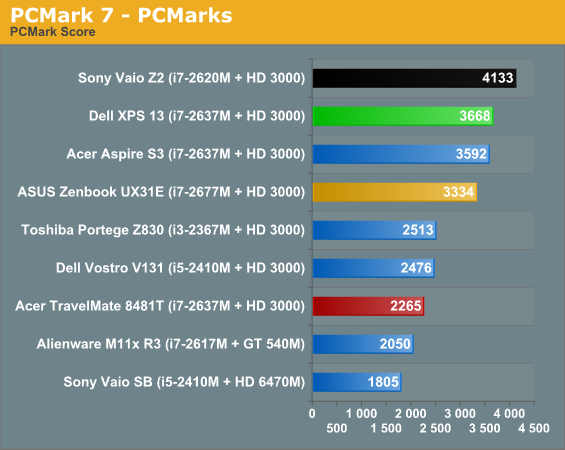
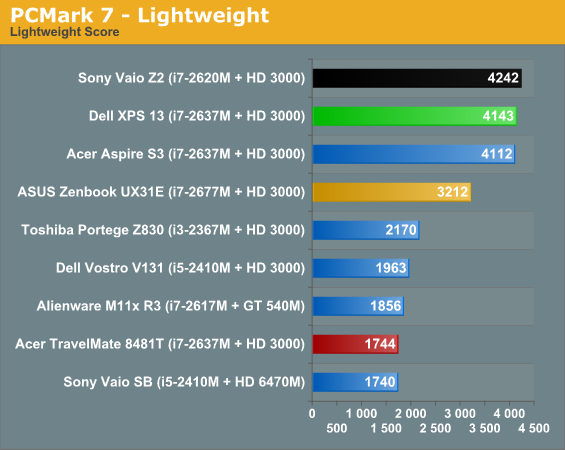

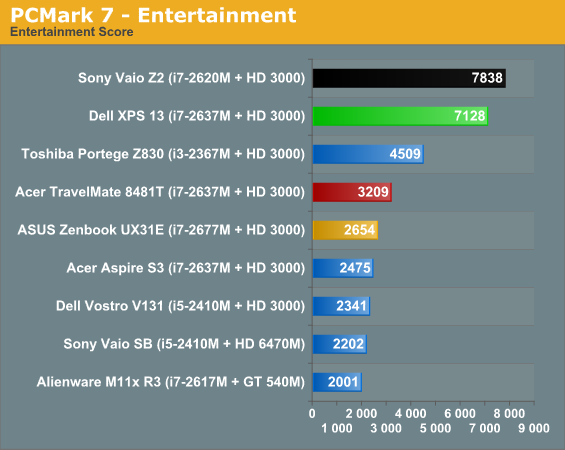

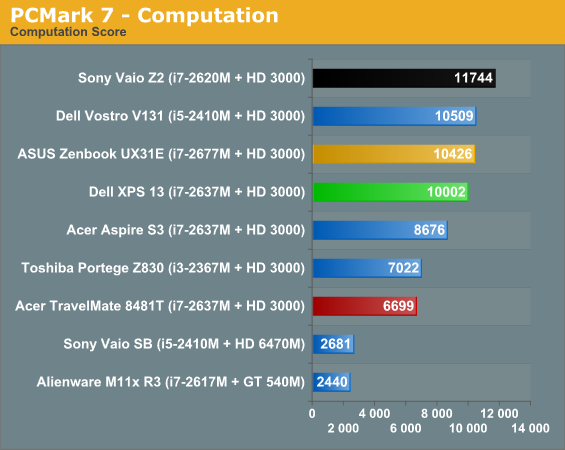
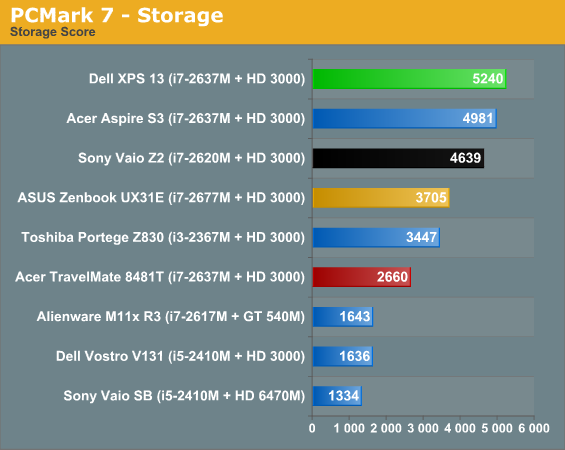
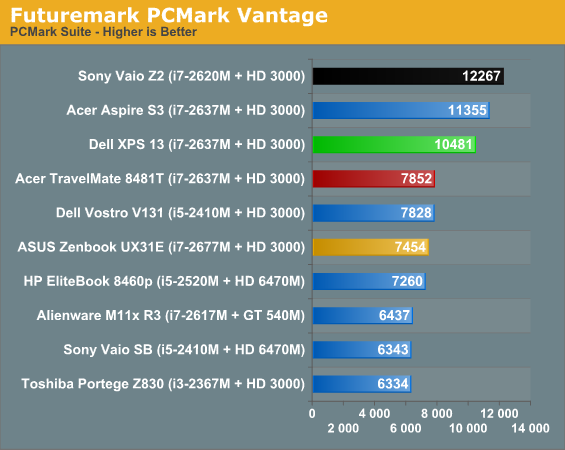
Our PCMark 7 results are mostly predictable, but the takeaway should really be that the Samsung 830 SSD is one of the best SSD solutions we've seen in an ultrabook thus far, even besting Sony's unusual RAID 0 configuration in the Vaio Z2. That lines up largely with conventional wisdom on desktop builds: a single 256GB SSD is generally preferable to a pair of 128GB SSDs in a striped RAID.
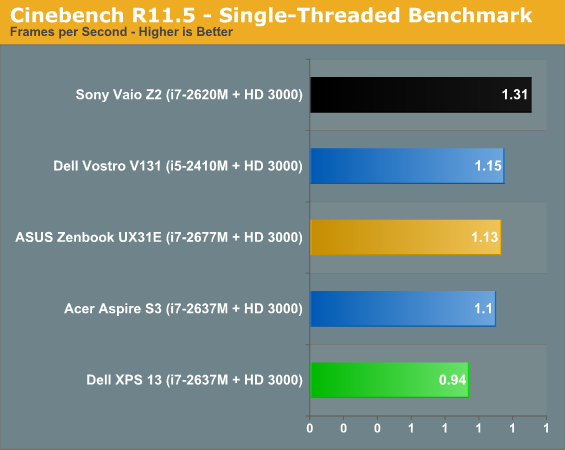
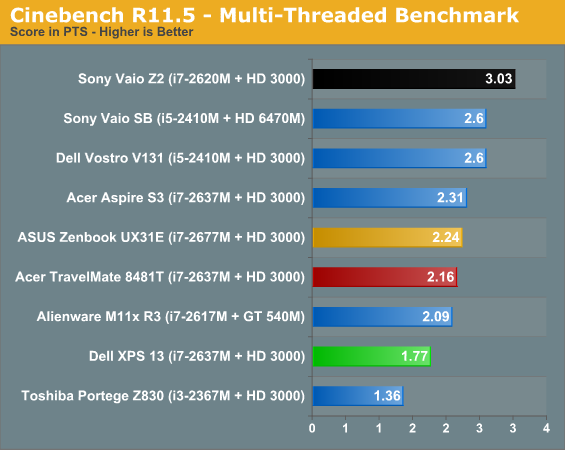

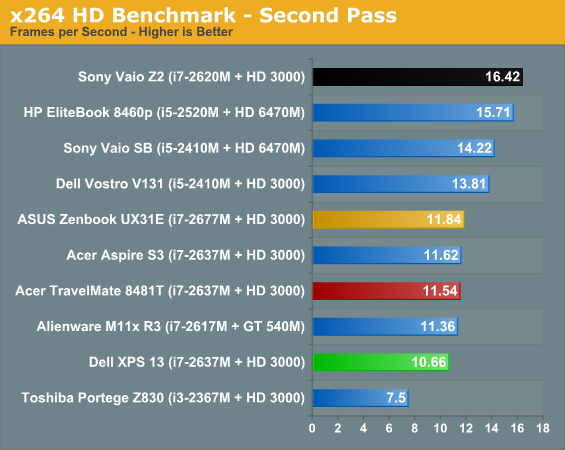
Unfortunately, you could argue the XPS 13 is also hitting some thermal limits as its application performance is a bit behind the curve. While the overall design of the XPS 13 is attractive, the cooling system causes the tiny fan to run at full bore just to keep temperatures manageable, and without that thermal overhead the chip has a harder time hitting and sustaining those high turbo clocks.


Our 3DMark results corroborate our other findings: where ultrabooks are concerned, the XPS 13 continues to be slightly behind the curve.










85 Comments
View All Comments
r3loaded - Tuesday, March 13, 2012 - link
All these bandwagon-jumping ultrabooks are soon to be rendered irrelevant by the upcoming Asus Zenbook UX21A/UX31A. Both will feature a 1920x1080 IPS panel as an upgrade option, immediately placing it above and beyond almost every other laptop in terms of display quality.ZekkPacus - Tuesday, March 13, 2012 - link
Thing is, a good panel shouldn't be an upgrade option. These devices are premium products - this ultrabook as reviewed is a $1500 machine. For that kind of cash, I want a 1440*900 IPS panel AS A MINIMUM.retrospooty - Tuesday, March 13, 2012 - link
I know, it sucks too, because this is a really nice laptop outside of the crap screen.mmaestro - Tuesday, March 13, 2012 - link
Agreed.What manufacturers don't seem to realize is that a large part of consumers' perception of quality is to do with the screen. It is, after all, the thing you spend all day staring at, and so if it's crap, it's what you'll notice. This is IMO why Apple has such a perception of quality to do with their products: They don't compromise on their screens, they use absolutely beautiful panels. Until other manufacturers try to compete with that then they'll carry the perception that their product is substandard. It's stupid, and this should be obvious. Yet next to no one seems to realize this.
fuzzymath10 - Tuesday, March 13, 2012 - link
I think in the price categories people focus on, screen quality is not very important. Seems like more cores, more GBs of RAM, more TBs of space (SSD loses out here where it shouldn't), more inches of LCD are what sell.Also, while high res displays have been an option for ages (my Dell Inspiron 8500 from 2003 has a 1680x1050 display which was a $100 upgrade from 1280x800, and another $100-150 got you 1920x1200), it did also cost me $2500. If we say that's $3000 today, we have many high res options at our disposal.
ThreeDee912 - Wednesday, March 14, 2012 - link
Apple seems to focus a lot on the things people actually interact with the most, like the screen, trackpad, keyboard, and battery, as well as build quality. The actual specs are balanced. Not excessively powered that it kills the battery, but now so crap that it makes things feel sluggish. It makes sense, and this strategy seems to be working well.It's somewhat like the megapixel (and now optical zoom) wars. There's a lot more to cameras then the spec sheet.
Sabresiberian - Tuesday, March 13, 2012 - link
It's not an Ultrabook, but Apple is rumored to be releasing a 2880x1800 notebook soon (2nd quarter this year is what I read), a notebook with closer to a tablet screen AND 16:10. I'm not a fan of Apple the company, but that's a head-turner for me, and it's the first time I've considered Apple in the running for a purchase since the Lisa (which was just dreaming back then as there was no way I could afford one).As far as I'm concerned, 16:9 is exponentially worse as screen size goes down; 16:10 or 4:3 should be what notebooks and smaller screen have.
;)
makaronen - Tuesday, March 13, 2012 - link
I created an account here just to applaud Dustin Sklavos in summarizing the annoyment I feel about PC manufacturers and the useless screens they put in premium laptops. A good screen in every high end laptop with stable viewing angles and high contrast should be a minimum as ZekkPacus puts it!Asus UX31A will hopefully be a game changer and a VERY late wake-up call for PC manufacturers...
Shadowmaster625 - Tuesday, March 13, 2012 - link
Wow it cant do anything without going to 80 celcius? lol what a piece of trash. Is that really what you get for $1000? What can this steaming pile of trash do that a $500 notebook cant do?Rinadien - Tuesday, March 13, 2012 - link
ummm.... weigh less than 3 lbs???